如果你需要保存密碼(比如網站用戶的密碼),你要考慮如何保護這些密碼數據,象下面那樣直接將密碼寫入數據庫中是極不安全的,因為任何可以打開數據庫的人,都將可以直接看到這些密碼。
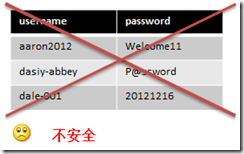
解決的辦法是將密碼加密後再存儲進數據庫,比較常用的加密方法是使用哈希函數(Hash Function)。哈希函數的具體定義,大家可以在網上或者相關書籍中查閱到,簡單地說,它的特性如下:
(1)原始密碼經哈希函數計算後得到一個哈希值
(2)改變原始密碼,哈希函數計算出的哈希值也會相應改變
(3) 同樣的密碼,哈希值也是相同的
(4) 哈希函數是單向、不可逆的。也就是說從哈希值,你無法推算出原始的密碼是多少
有了哈希函數,我們就可以將密碼的哈希值存儲進數據庫。用戶登錄網站的時候,我們可以檢驗用戶輸入密碼的哈希值是否與數據庫中的哈希值相同。
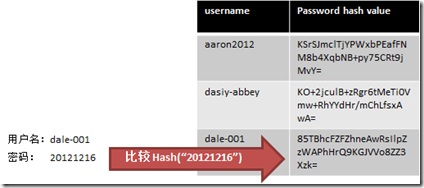
由於哈希函數是不可逆的,即使有人打開了數據庫,也無法看到用戶的密碼是多少。
那麼存儲經過哈希函數加密後的密碼是否就是安全的了呢?我們先來看一下幾種常見的破解密碼的方法。
最簡單、常見的破解方式當屬字典破解(Dictionary Attack)和暴力破解(Brute Force Attack)方式。這兩種方法說白了就是猜密碼。
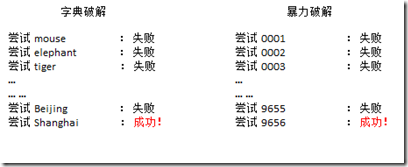
字典破解和暴力破解都是效率比較低的破解方式。如果你知道了數據庫中密碼的哈希值,你就可以采用一種更高效的破解方式,查表法(Lookup Tables)。還有一些方法,比如逆向查表法(Reverse Lookup Tables)、彩虹表(Rainbow Tables)等,都和查表法大同小異。現在我們來看一下查表法的原理。
查表法不像字典破解和暴力破解那樣猜密碼,它首先將一些比較常用的密碼的哈希值算好,然後建立一張表,當然密碼越多,這張表就越大。當你知道某個密碼的哈希值時,你只需要在你建立好的表中查找該哈希值,如果找到了,你就知道對應的密碼了。
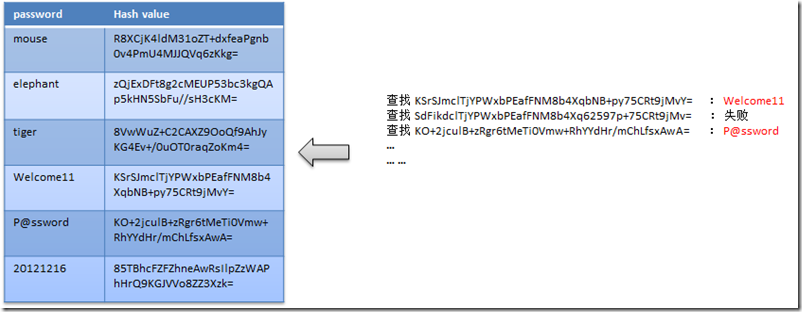
從上面的查表法可以看出,即便是將原始密碼加密後的哈希值存儲在數據庫中依然是不夠安全的。那麼有什麼好的辦法來解決這個問題呢?答案是加鹽。
鹽(Salt)是什麼?就是一個隨機生成的字符串。我們將鹽與原始密碼連接(concat)在一起(放在前面或後面都可以),然後將concat後的字符串加密。采用這種方式加密密碼,查表法就不靈了(因為鹽是隨機生成的)。
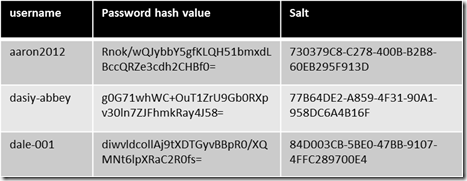
在.NET中,生成鹽可以使用RNGCryptoServiceProvider類,當然也可以使用GUID。哈希函數的算法我們可以使用SHA(Secure Hash Algorithm)家族算法,當然哈希函數的算法有很多,比如你也可以采用MD5。這裡順便提一下,美國政府以前廣泛采用SHA-1算法,在2005年被我國山東大學的王小雲教授發現了安全漏洞,所以現在比較常用SHA-1加長的變種,比如SHA-256。在.NET中,可以使用SHA256Managed類。
下面來看一段代碼演示如何在.NET中實現給密碼加鹽加密。加密後的密碼保存在MySQL數據庫中。


下面的代碼演示如何注冊一個新帳戶。鹽的生成可以使用新Guid,也可以使用RNGCryptoServiceProvider 類。將byte[]轉換為string,可以使用Base64String,也可以使用下面的ToHexString方法。
protected void ButtonRegister_Click(object sender, EventArgs e)
{
string username = TextBoxUserName.Text;
string password = TextBoxPassword.Text;
// random salt
string salt = Guid.NewGuid().ToString();
// random salt
// you can also use RNGCryptoServiceProvider class
//System.Security.Cryptography.RNGCryptoServiceProvider rng = new System.Security.Cryptography.RNGCryptoServiceProvider();
//byte[] saltBytes = new byte[36];
//rng.GetBytes(saltBytes);
//string salt = Convert.ToBase64String(saltBytes);
//string salt = ToHexString(saltBytes);
byte[] passwordAndSaltBytes = System.Text.Encoding.UTF8.GetBytes(password + salt);
byte[] hashBytes = new System.Security.Cryptography.SHA256Managed().ComputeHash(passwordAndSaltBytes);
string hashString = Convert.ToBase64String(hashBytes);
// you can also use ToHexString to convert byte[] to string
//string hashString = ToHexString(hashBytes);
var db = new TestEntities();
usercredential newRecord = usercredential.Createusercredential(username, hashString, salt);
db.usercredentials.AddObject(newRecord);
db.SaveChanges();
}
string ToHexString(byte[] bytes)
{
var hex = new StringBuilder();
foreach (byte b in bytes)
{
hex.AppendFormat("{0:x2}", b);
}
return hex.ToString();
} 下面的代碼演示了如何檢驗登錄用戶的密碼是否正確。首先檢驗用戶名是否存在,如果存在,獲得該用戶的鹽,然後用該鹽和用戶輸入的密碼來計算哈希值,並和數據庫中的哈希值進行比較。
protected void ButtonSignIn_Click(object sender, EventArgs e)
{
string username = TextBoxUserName.Text;
string password = TextBoxPassword.Text;
var db = new TestEntities();
usercredential record = db.usercredentials.Where(x => string.Compare(x.UserName, username, true) == 0).FirstOrDefault();
if (record == default(usercredential))
{
throw new ApplicationException("invalid user name and password");
}
string salt = record.Salt;
byte[] passwordAndSaltBytes = System.Text.Encoding.UTF8.GetBytes(password + salt);
byte[] hashBytes = new System.Security.Cryptography.SHA256Managed().ComputeHash(passwordAndSaltBytes);
string hashString = Convert.ToBase64String(hashBytes);
if (hashString == record.PasswordHash)
{
// user login successfully
}
else
{
throw new ApplicationException("invalid user name and password");
}
}總結:單單使用哈希函數來為密碼加密是不夠的,需要為密碼加鹽來提高安全性,鹽的長度不能過短,並且鹽的產生應該是隨機的。
本文轉自:http://www.csharpwin.com/csharpspace/13412r9615.shtml